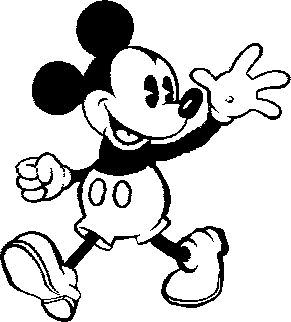 MICKEY'S HOME PAGE
MICKEY'S HOME PAGE MICKEY'S HOME PAGE
MICKEY'S HOME PAGE
From his conception as an artificial image on the animated screen Mickey Mouse has evolved and become a universal icon. His presence has been integrated into virtually every facet of our society. There were different representaions of Mickey Mouse. There were his movie star days, to the Mickey Mouse Club, Disney World and Disneyland, and many other roles Mickey Mouse has played in our society. Mickey Mouse's image has, more than any other image, become an entity in itself, separate from the traditional character of Mickey Mouse. It is a vital possession for the Walt Disney Company to the degree that they will probably shut down my page for using it. His image has been circulated and used around the world as a type of commodity; wearing it can symbolize anything from 'owning' a portion of the fantasy of Disney to participating in the capitalist dream of the United States.
HISTORY
 Mickey Mouse began his career as a figment of Walt Disney's imagination in 1928. There are many stories of his conception, but the one most commonly believed is that Walt and his wife, Lillian, invented the mouse on the return of a business trip from New York back to California. Having in mind the field mice which roamed into his studio in Kansas City, Walt suggested the name Mortimer. Lillian, however, thought the humble name of Mickey, was a more appropiate choice. It is this very 'humble' and common image of Mickey which has allowed for his evolution and made him applicable to every element of society. From 1928 to 1990, Mickey has remained immortally a personification of Disney and laughter. Through his 135 films, the Mickey Mouse Club, his occupation as everyone's favorite toy, and hosting vacationers at Disneyland and Disney World, he has become a timeless image, no longer simply the mouse of Disney's success but an intentity in himself.
Mickey Mouse began his career as a figment of Walt Disney's imagination in 1928. There are many stories of his conception, but the one most commonly believed is that Walt and his wife, Lillian, invented the mouse on the return of a business trip from New York back to California. Having in mind the field mice which roamed into his studio in Kansas City, Walt suggested the name Mortimer. Lillian, however, thought the humble name of Mickey, was a more appropiate choice. It is this very 'humble' and common image of Mickey which has allowed for his evolution and made him applicable to every element of society. From 1928 to 1990, Mickey has remained immortally a personification of Disney and laughter. Through his 135 films, the Mickey Mouse Club, his occupation as everyone's favorite toy, and hosting vacationers at Disneyland and Disney World, he has become a timeless image, no longer simply the mouse of Disney's success but an intentity in himself.
John Updike analizes the image of Mickey Mouse in Craig and Janet
Morra-Yoe's book The_Art_of_Mickey_Mouse. He includes a quote from Walt Disney himself that seems to be pertinent to this discussion of Mickey's image:
" Sometimes I've tried to figure out why Mickey appealed to the whole world. Everybody's tried to figure it out.So far as I know, nobody has. He's a pretty nice fellow who never does anybody any harm, who get into scrapes through no fault of his own, but always managed to come up grinning ."
